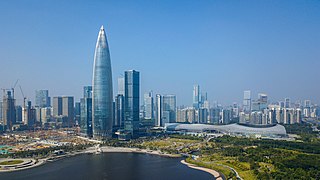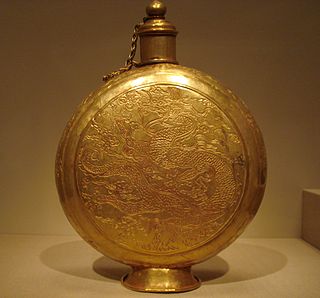
Asia is the largest continent in the world by both land area and population. It covers an area of more than 44 million square kilometers, about 30% of Earth's total land area and 8% of Earth's total surface area. The continent, which has long been home to the majority of the human population, was the site of many of the first civilizations. Its 4.7 billion people constitute roughly 60% of the world's population.

China, officially the People's Republic of China (PRC), is a country in East Asia. With a population exceeding 1.4 billion, it is the world's second-most-populous country. China spans the equivalent of five time zones and borders fourteen countries by land. With an area of nearly 9.6 million square kilometers (3,700,000 sq mi), it is the third-largest country by total land area. The country is divided into 33 province-level divisions, inclusive of 22 provinces, five autonomous regions, four municipalities, and two semi-autonomous special administrative regions. Beijing is the national capital, while Shanghai is its most populous city and largest financial center.

Guangzhou, also known as Canton, is the capital and largest city of Guangdong province in southern China. Located on the Pearl River about 120 km (75 mi) north-northwest of Hong Kong and 145 km (90 mi) north of Macau, Guangzhou has a history of over 2,200 years and was a major terminus of the Silk Road.

Hong Kong, officially the Hong Kong Special Administrative Region of the People's Republic of China, is a city and a special administrative region in China. With 7.4 million residents of various nationalities in a 1,104-square-kilometre (426 sq mi) territory, Hong Kong is one of the most densely populated territories in the world.

The economy of Hong Kong is a highly developed free-market economy. It is characterised by low taxation, almost free port trade and a well-established international financial market. Its currency, called the Hong Kong dollar, is legally issued by three major international commercial banks, and is pegged to the US dollar. Interest rates are determined by the individual banks in Hong Kong to ensure that they are market driven. There is no officially recognised central banking system, although the Hong Kong Monetary Authority functions as a financial regulatory authority.

The economy of Vietnam is a developing mixed socialist-oriented market economy incorporating industrial policies and strategic five-year plans, which is the 35th-largest in the world as measured by nominal gross domestic product (GDP) and 26th-largest in the world as measured by purchasing power parity (PPP) in 2022. It is a lower-middle income country with a low cost of living. Vietnam is a member of the Asia-Pacific Economic Cooperation, the Association of Southeast Asian Nations and the World Trade Organization.

The Silk Road was a network of Eurasian trade routes active from the second century BCE until the mid-15th century. Spanning over 6,400 kilometers, it played a central role in facilitating economic, cultural, political, and religious interactions between the East and West. The name "Silk Road", first coined in the late 19th century, has fallen into disuse among some modern historians in favor of Silk Routes, on the grounds that it more accurately describes the intricate web of land and sea routes connecting Central, East, South, Southeast, and West Asia as well as East Africa and Southern Europe.

Guangdong, formerly romanized as Canton or Kwangtung, is a coastal province located in South China, on the north shore of the South China Sea. The provincial capital is Guangzhou. With a population of 126.84 million across a total area of about 179,800 km2 (69,400 sq mi), Guangdong is the most populous province of China and the 15th-largest by area as well as the second-most populous country subdivision in the world.

The economy of Asia comprises about 4.7 billion people living in 50 different nations. Asia is the fastest growing economic region, as well as the largest continental economy by both GDP Nominal and PPP in the world. Moreover, Asia is the site of some of the world's longest modern economic booms.

Chaoshan or Teoswa is a cultural-linguistic region in the east of Guangdong, China. It is the origin of the Min Nan Chaoshan dialect (潮汕话). The region, also known as Chiushan in Cantonese, consists of the cities Chaozhou, Jieyang and Shantou. It differs linguistically from the rest of Guangdong province, which was historically dominated by Yue speakers, Hakka, and Leizhou Min speakers. However, Mandarin has recently become the dominant language in the region. It is historically important as the ancestral homeland of many citizens of other countries of Chinese descent, including Viets, Thais, Cambodians, Singaporeans, Malaysians, and Indonesians.

The Sinosphere, also known as the Chinese cultural sphere, East Asian cultural sphere, or the Sinic world, encompasses multiple countries in East Asia and Southeast Asia that historically were heavily influenced by Chinese culture, norms and traditions. According to academic consensus, the Sinosphere comprises Greater China, Japan, Korea, and Vietnam. Other definitions may include the regions of modern-day Mongolia and Singapore, largely due to limited historical Chinese influences or increasing modern-day Chinese diaspora. The Sinosphere is not to be confused with Sinophone, which indicates countries where a Chinese-speaking population is dominant.

The economy of East Asia comprises 1.6 billion people living in six different countries and regions. The region includes several of the world's largest and most prosperous economies: Taiwan, Japan, South Korea, China, Hong Kong, and Macau. It is home to some of the most economically dynamic places in the world, being the site of some of the world's most extended modern economic booms, including the Taiwan miracle (1950–present) in Taiwan, Miracle on the Han River (1974–present) in South Korea, Japanese economic miracle (1950–1990) and the Chinese economic miracle (1983–2010) in China.

China has an upper middle income, developing, mixed, socialist market economy incorporating industrial policies and strategic five-year plans. It is the world's second largest economy by nominal GDP, behind the United States, and the world's largest economy since 2016 when measured by purchasing power parity (PPP). Due to a volatile currency exchange rate, China's GDP as measured in dollars fluctuates sharply. China accounted for 19% of the global economy in 2022 in PPP terms, and around 18% in nominal terms in 2022. Historically, China was one of the world's foremost economic powers for most of the two millennia from the 1st until the 19th century. The economy consists of public sector enterprises, state-owned enterprises (SOEs) and mixed-ownership enterprises, as well as a large domestic private sector and openness to foreign businesses in their system. Private investment and exports are the main drivers of economic growth in China, but the Chinese government has also emphasized domestic consumption. Post-1978 economic reforms China's average GDP growth has been over 10% annually for over three decades. And in certain years, GDP growth even exceeded 13% annually. Though in recent years, their growth has significantly plummeted.

East Asia is a region of Asia, which is defined in both geographical and ethno-cultural terms. The modern states of East Asia include China, Japan, Mongolia, North Korea, South Korea, and Taiwan. Hong Kong and Macau, two coastal cities located in the south of China, are autonomous regions under Chinese sovereignty. The economies of Japan, South Korea, China, Taiwan, Hong Kong, and Macau are some of the world's largest and most prosperous economies. East Asia borders Siberia and the Russian Far East to the north, Southeast Asia to the south, South Asia to the southwest, and Central Asia to the west. To the east is the Pacific Ocean and to the southeast is Micronesia.

The economy of the Ming dynasty (1368–1644) of China was one of the largest in the world during that period. It is regarded as one of China's three major golden ages. The period was marked by the increasing political influence of the merchants, the gradual weakening of imperial rule, and technological advances.

The economic history of China covers thousands of years and the region has undergone alternating cycles of prosperity and decline. China, for the last two millennia, was one of the world's largest and most advanced economies. Economic historians usually divide China's history into three periods: the pre-imperial era before the rise of the Qin; the early imperial era from the Qin to the rise of the Song ; and the late imperial era, from the Song to the fall of the Qing.
The Chinese economic reform or Chinese economic miracle, also known domestically as reform and opening-up, refers to a variety of economic reforms termed "socialism with Chinese characteristics" and "socialist market economy" in the People's Republic of China (PRC) that began in the late 20th century. Guided by Deng Xiaoping, who is often credited as the "General Architect", the reforms were launched by reformists within the ruling Chinese Communist Party (CCP) on December 18, 1978, during the "Boluan Fanzheng" period.

The economy of Chongqing, China, has developed rapidly since it was separated from the Sichuan and became a centrally-administered municipality in 1997. In 2019, it was the sixth-largest Chinese city economy and ranked as China's third-largest municipal economy. In China's overall layout, Chongqing is also important for connecting China's underdeveloped western region with its more advanced eastern region, as well as promoting the economy of the mid-lower reaches of Yangtze river and the central western region.

The Guangdong–Hong Kong–Macao Greater Bay Area, commonly known as the Greater Bay Area (GBA), is a megalopolis, consisting of nine cities and two special administrative regions in South China. It is envisioned by Chinese government planners as an integrated economic area aimed at taking a leading role globally by 2035.

















